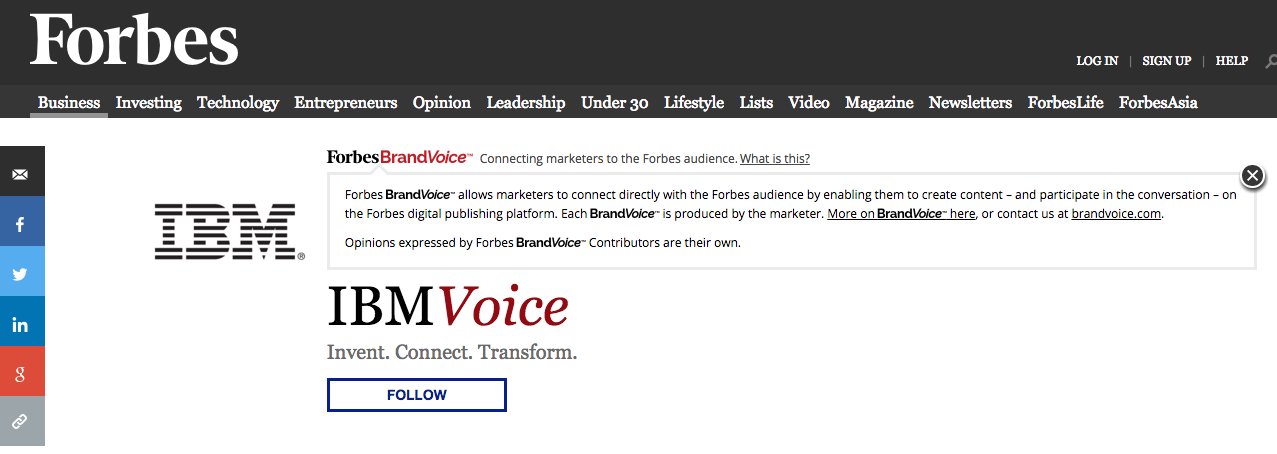This post first appeared on the Knight Digital Media Center’s site.
As display advertising rates drop and use of online ad blockers increases, many news publishers are turning to native advertising, particularly sponsored content, for revenue.
In a new study, “The Rise of Native Ads in Digital News Publications,” for the Tow-Knight Center for Entrepreneurial Journalism at City University of New York, I looked at sponsored content through the lenses of 14 news organizations, including prominent national publications such as Forbes and the New York Times, local newspaper and broadcast companies, and smaller digital-native news startups.
While a major type of native advertising is in-feed promotions — typically seen on social media platforms — news publishers in the study typically are creating and/or distributing sponsored stories that do not always include direct promotions.
The content is designed to mimic or blend in with editorial content, and it takes as many forms as editorial. Examples range from sophisticated story packages to sponsor-written posts. The publications use a variety of media, including text, interactives, videos and photos, and extend the reach of the content via social media and e-newsletter promotions.
For the most part, these news organizations are aiming to provide content that is relevant, useful and/or entertaining to their readers, and most avoid stories that directly promote the advertiser’s product or service. In many ways, the content is less in your face than some other forms of advertising, but it has nonetheless created confusion and skepticism among the public and drawn scrutiny from the Federal Trade Commission.
5 Types of Native Ads
In studying the sponsored content at the 14 news publications, I saw content that fit within these broad categories:
- Contextual: The content relates to the environment in which the sponsor and its potential customers operate, often exploring and explaining complex issues. Example: Forbes’ BrandVoice™ creates or collaborates with brands to create custom packages, such as a Toyota-sponsored interactive examining historical skepticism about new technology.
- Thought leadership: This content, usually produced by the advertiser, highlights sponsor expertise on topics that are relevant to a publication’s readership. Example: The Texas Tribune, a nonprofit news site that covers state government, offers sponsors the opportunity to write policy-focused op-eds that are published on its TribTalk opinion site.
- Tips and advice: This content offers practical tips in areas that may relate to the sponsor’s product. Example: On Deseret Digital’s BrandView, a local grocery chain sponsored two popular series of weekly columns: “Ask a Chef” and “Ask a Dietician.”
- Promotional: The content features the sponsoring organization but may or may not have a call to action or direct sales pitch. Example: Local News Now, a small group of online news sites in the Washington, D.C. area, offers several options, including sponsor-written – such as “Just Reduced” posts by a real estate agent — and one-time promotional articles.
- Independently produced journalism: The advertiser agrees to sponsor content about a topic but has no influence on what any particular story on the topic will say. Example: A treatment center sponsored a story and graphic about mental health on Scripps sites:
This post first appeared on the Knight Digital Media Center’s site.
Coming soon: In spite of labels, consumers confused, skeptical about native ads
Michele McLellan is a writer, editor and consultant who works on projects that help strengthen the emerging local news ecosystem, whether it is online news start ups working to become sustainable or traditional news organizations that are trying to shape their new role in the digital world. In addition to being the senior program consultant for Knight Digital Media Center, Michele has served as a Knight Community Information Challenge Circuit Rider who advises community foundations that are supporting news and information projects in their areas. She founded the Block by Block Community News Summit for independent online community publishers and she created and publishes Michele’s List, a database of promising local news start ups, in collaboration with the Tow-Knight Center for Entrepreneurial Journalism.


